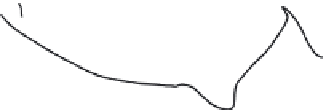Biology Reference
In-Depth Information
4
3
5
2
6
15
7
1
14
16
8
13
12
11
10
9
(A)
(B)
(C)
FIGURE 1.5
Ontogenetic shape change depicted in two visual styles. (A) Landmarks of all specimens; (B) vectors
of relative landmark displacement; (C) deformed grid.
Figure 1.5
, shows that the middle of the body grows faster and becomes deeper than the
rest of the animal. The limitation of this representation (and of the analysis) is exemplified
by the difficulty of interpreting the large coefficient (1.23) of the posterior segment of
dorsal head length
it is not clear whether the head is just elongating rapidly in this area
or if it is mainly deepening or if it is both elongating and deepening. We also cannot tell
if the pre- and postorbital head increase at the same rate because the measurement scheme
does not include distances from the eye to other landmarks. None of these ambiguities
arose from the geometric analysis of the landmark coordinates; the figure illustrating that
result showed the ontogenetic changes in all those specific regions. This ability to extract
and communicate information about the spatial localization of morphological variation,
including its magnitude, position and spatial extent, is among the more important benefits
of geometric morphometrics. Following the statistical analysis, which allows us to determine
which factors have an effect on shape, we can diagram the effects of the factors.




























































































































































































































































































































































































































































































































































































































































































































































